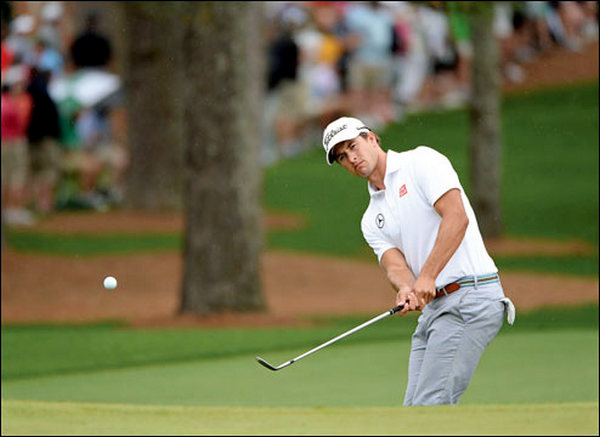Textbook cues from Masters champion, Adam Scott, can help you to jump-start a winning season
By Jonathan Yarwood with Richard Simmons
Golf’s nearly man is now a really man! The most talented golfer to come out of Australia since his hero, mentor, long-time friend and fellow Queenslander Greg Norman, Adam Scott looked destined to be lumbered with the dubious tag-line ‘best player to never win a major’ – right up until the moment he played his way into the record books at Augusta with some of the most fabulous ball-striking ever seen down the final stretch of a major championship to edge out the 2009 champion, Angel Cabrera.
This was a measured, controlled and composed performance that underlined Scott’s reputation as one of the finest professionals of his generation, and the standard of his shot-making and pure striking over the final holes, not to mention the nerve he displayed with his putter when it absolutely mattered, not only silenced his critics but those who questioned caddie Steve Williams’ credentials following events at Royal Lytham last summer. Ever gracious, Scott credited Williams with a killer read on the second playoff hole, where Tiger’s former bagman urged him to double the amount of break he read into the slick, curling 15-footer he faced for victory. “I asked Steve if it was a cup outside the right, and he told me is was at least two cups,” said the new champion. “That was some call.”
Whenever I’m asked to nominate my favourite swing in golf, Adam Scott is usually the first name that pops into my head. At six feet tall and athletic with it, he has a perfect physique for the game at the highest level – and of course he has the benefit of being very well coached. He was a student of Butch Harmon from 1995-2010, a period that coincided with Tiger’s best years under the same tutor, and if ever you saw the two of them hitting balls on the range in silhouette it was tough to tell them apart. Scott left to work with his brother-in-law, Brad Malone, but in essence he retains the beautiful lines and plays with the philosophy Butch instilled in him, and he is a model for all young players to follow.
So, with a little journalistic licence, let me indulge you with a look at one of the greatest moves in the game today, and some of the key shots that won the Masters – a victory that took Scott to No. 3 in the world.
Swing geometry & synchronisation
When you look at Adam’s golf swing, it all just looks so simple. There’s a real economy of movement with all of the vital parts working together in concert – and in a deceptively powerful sequence (such as this one, shot just a couple of weeks prior to Augusta).


To stand next to him on the range is to experience an explosion of speed as he rips through the ball with incredible dynamic force. One of the notable things about Adam’s golf swing is the way his hands work ‘up and down’. Watch the re-runs of those Masters highlights you have saved on Sky+ and study the way he swings his hands up into a relatively high position at the top. Looking down the line his hands are directly above the tip of his right shoulder. A lot of players get their hands deep and ‘behind’ them, which can cause them to shoot out (forward) in the downswing, creating all sorts of compensations due to the steep downswing plane that produces. Take note…
My preference is to see the left arm work up the chest somewhat, a la Faldo, especially for tall long-lever players (as discussed last issue). This gives the arms some range and height, which allows them to work back down on a similar track producing a shallow plane. One of the hallmarks of a great ball-striker.
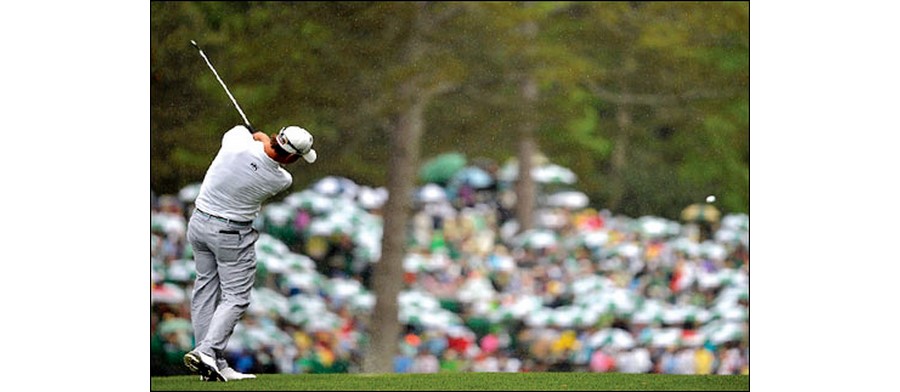
Total commitment and trust in his swing enabled him to rifle in one great iron shot after another, such as this one at 15 on Sunday.
Next time you go out to practise, make a few swings consciously working your left arm up your chest to create the backswing and then down (feel like it’s across) your chest on the way back down. You can try this with or without a club. In fact, a good training drill at home is to hold a football between the palms of the hands and work it up and down as you turn your trunk. ‘Sync up’ the arms, ball and body.
Another great aspect of Adam’s swing is the way in which he gets his hips and shoulders open at impact a similar amount whilst maintaining his original posture angles. This is a great thing to copy and will result in amazing strike and control of the ball. Many players get their hips open at impact too soon. The problem then is that the upper body can never catch up, so the player ends up with the look of their chest being square, hips open and spine raising at impact. This leads to much fiddling with the hands through the ball and the inevitable errant shots.
Another exercise: get into your set-up position, then turn your hips and chest towards the target as if to replicate where you want them to be at impact. Hold that for a few seconds, feel it, and then make a short backswing and try to return to this impact position for real, hitting a mid iron. You will instantly compress the ball.
The proof of the pudding is in the eating.
When Adam hit that piercing second shot (5- iron) into the par-five 15th on the last day, and another laser-guided iron shot into the 10th, the second playoff hole, you just knew this was a technique that could stand up to anything. Study the image above; look at the way he has retained spine angle while the shoulders rotate perfectly about that axis. Total trust and commitment through the ball.
Driver on 18; ripped (both times on Sunday)
While there may be room for comparison with Tiger in certain aspects of the swing, there is none when it comes to hitting the driver. Adam Scott is probably the best driver of the ball in the game today. He is long, straight, and fearless with it. And the reason he is so dependable comes right back to the basics: a technically excellent set-up position leads to a textbook golf swing.

Just look at the clearance here with the driver, creating room for the arms to deliver the final blow
The quality of the set-up is a huge factor in hitting the driver well. And with the emphasis on the importance of driving the ball well in the game today, this is a non-negotiable lesson for every aspiring player. Understand that it is vital you get your stance a little wider here than you do to hit irons. This provides the solid base you need to wind up your body fully and retain control.
The other key element many people forget is that the spine has to be tilted away from the target, so that the left hip pocket feels a little higher than the right, and the weight feels 60% on the right foot. Lastly, tee the ball up high. You are looking to create ‘high launch, low spin’ with the modern driver. The lower you tee it, the more you are inclined to strike down on it, creating excessive spin. Tee it high, collect it as you swing through ever so slightly on the up, and watch it fly!
From this athletic set-up, Adam can really wind into his right knee and get his upper body wound behind the ball. As with his iron swing, his hands work up his chest, not so much around his body, to compliment this.
The change of direction is crucial. Many people rush from the top and start their driver swing from the top down towards the ground. With a driver it is vital that you start with your lower body driving gently towards the target. This allows the upper body to stay back behind the ball and allows the arms time to relocate into the shallow position (as you see here). The upper body stays more behind the ball than an iron to encourage an upward sweeping action which is necessary to launch your driver.
A great exercise to feel this is to hit some drivers from an uphill slope. Playing uphill, as it were, will automatically encourage you to create that tilt away from the target, get your weight favouring your right side. That will keep you more behind the ball and create the conditions you need to nail it like Adam.
Controlled draw, 10 tee
The dogleg 10th hole at Augusta turns right-to left down the hill much sharper than it looks on TV. There is also a huge elevation change. From the tee, you can only see the fairway to about one hundred yards out then it disappears giving you only the pine trees in the distance as targets. You have to trust that you have the right line with the right shape. There is only one shot, a 20-yard draw. Most players use a 3-wood as it is easier to work the ball with a club with more loft (but wasn’t Cabrera’s raking 2-iron a fantastic reply with Scott already in great shape in the playoff?).
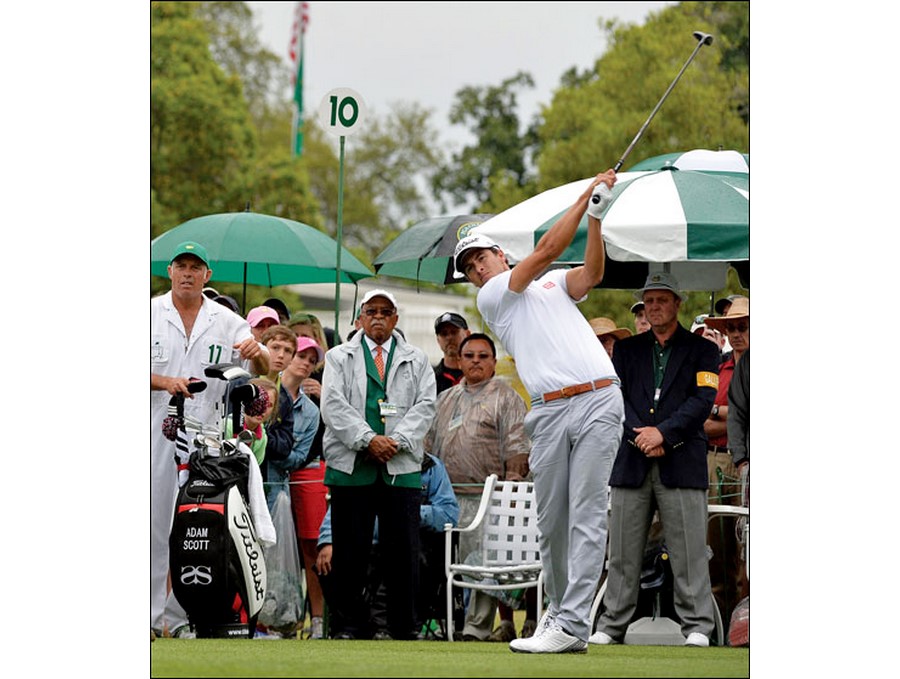
A simple way to draw it is to create the setup geometry that will produce it. A simple equation to do so is this: aim your body where you want the ball to start. Aim your clubface where you want the ball to finish, then grip it. Do not grip it then close the face as it will only end up square at address. Keep the ball forward with the 3-wood and tilt your spine back.
In your swing it will not hurt to feel like you drop your right shoulder on the way down and hit the inside of the ball. This will create the shallow plane and in-to-out path that you’ll need. How much draw you get is dictated by how you set up, but also by your forearm rotation through the ball. Rotate them hard and it will curve more. One important point is that you make sure you start it right of target and draw it back. You do not want to hit ‘double-cross’ draws, which start left and go left!
Precision pitching
As with many pros, Adam’s distance control with his pitch shots is exemplary.

The arms and elbows stay pretty much where they were at the set-up in relation to his turning trunk – and that’s a recipe for precision
Contrary to his full swing, he moves his arms and body at a similar speed. His trunk rotates back and through and his arms and elbows stay pretty much where they started at address in relation to this turning trunk.
The wrists gently hinge the club on the way back and through relative to the distance the ball should go. He never rushes a pitch swing.
The tempo is pretty similar back and through with only a slight acceleration in the downswing.
You want to experience the same sensation of ‘togetherness’ that gives you such a fine feel and speed control? Go out and hit some pitch shots with the ends of a towel under your arms to feel the body controlling them and everything staying in sync. Another good image is to hold a ball in between your hands and try and keep it opposite your chest as you turn it.
Pitching is not about how far, per se, you can hit a particular club, it is about having the ability to land one ball after another on exactly the same number. Take your favourite pitching clubs and go out and dedicate some time to blending this arm-and-torso movement, and measure your ‘best’ distances with each one.
Delicate chipping: Stand tall to the ball
Although Adam hit a lot of greens over all four days, he was still faced with some tough little chips during the week. One of the secrets to controlling he strike, especially on Augusta’s tight lies, is to stand relatively close to the chip shot. If you stand closer and grip a little down the club this immediately gives you more control, due to the fact your body and arms enjoy a closer working relationship throughout the execution of the shot. Standing a tad closer also encourages the club to stay outside your hands and does not allow it to get behind you, which is a killer move on a short shot like a chip which has no dynamic movement to get you out of jail.
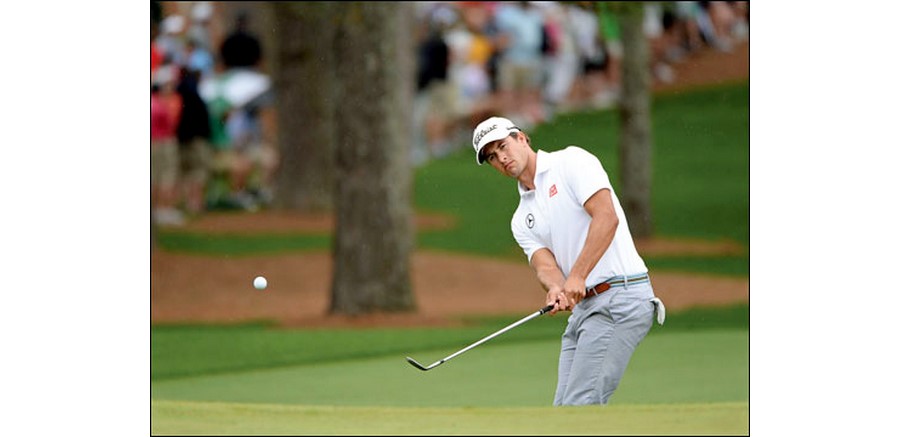
Lastly, standing close also raises the heel of the club up off the ground slightly. This gets the club more on its toe. There is less bounce on the toe. In chipping bounce is your enemy, as it stops the front edge of the club from pinching the turf. The more you can keep that out of the equation on delicate shots the better.
Try the same shot but use a 3-wood in place of a wedge. This is a shot that Adam played at Augusta. It is great as you cannot mis-hit the shot. The sole of the club is wide and this makes it skid. You will build an insurance policy into your chipping game as Adam has and this will not allow you to mishit the shot, just by standing much closer
The key to making clutch putts
Obviously putting is key to winning any golf tournament. But with greens as fast and as complicated as they are at Augusta National, it is a ‘must’ to master the greens (as Steve Williams proved). Putting used to be Adam’s Achilles Heel. It was the only thing holding him back. His putting stroke with a normal putter is, to say the least, suspect, prone to nerves and no consistency. His salvation has come with the long putter and claw grip!
I like the concept of the claw grip. You literally put the grip between your right thumb and palm. Get the rest of your hand parallel to the face. With one end anchored by your left hand, simply make a ‘swinging’ action with that hand to create a nice path to your stroke.
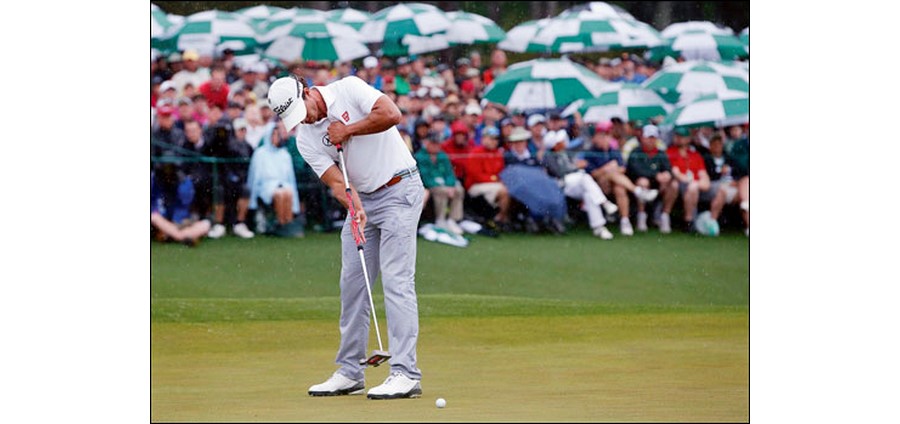
He didn’t speed up, he didn’t slow down. He went about his business as he always does, walked the line with his eyes and trusted his stroke
I also think you can learn from a belly or broomhandle putter. The reason I think they should not be allowed is the main reason why I think it is good for your game! Namely, the anchored fulcrum of them allows the club to get in sync and produces a consistent pendulum action. This creates a symmetry to the stroke in both length and rhythm which allows the club to go the same distance back and through as it should. It also creates economy of movement and does not allow your arms to get out of sync or independent of your body. You can turn your putter into a temporary anchored putter by turning a club upside down and holding it at the side of your putter with it jammed into your bod, a great little drill.
One other thing that Adam did like clockwork on Sunday was adhere to his pre-putt routine. And the aspect I found intriguing was the way he ‘walked’ his eyes down the line of the putt by swiveling his head sideways. Then he would walk his eyes slowly back down to the ball and make the stroke without further hesitation. He did this pretty slowly and deliberately.
He was locked into micro-contours and aspects of the line to create the roadmap to the hole. There is a huge difference between a routine and a ritual. A routine has emotion and ritual does not. Pour some effort and emotion into burning your eyes along the line of the putt. Then execute the shot and stay down on it by swivelling your eyes not moving your whole head.
You may never win a green jacket but there is no reason why you cannot become better at some of these key shots and learn to play like a true champion this summer.
Originally published in 2014
